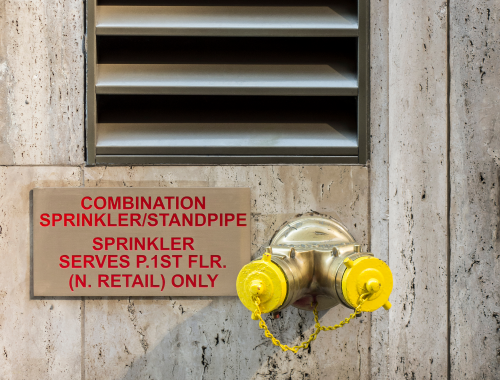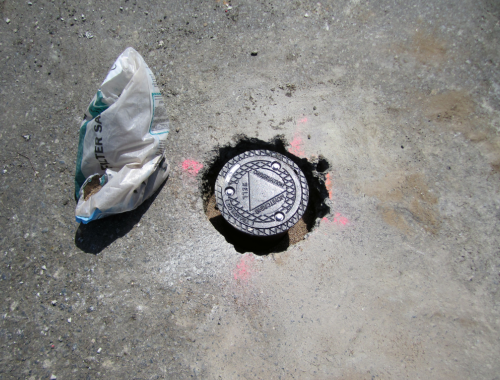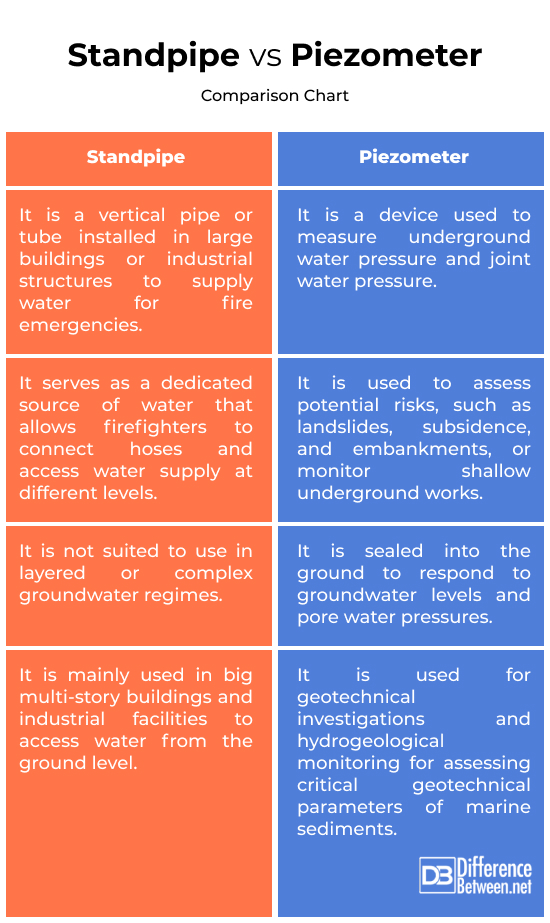Difference Between Standpipe and Piezometer
Standpipes and piezometers are two of the most common engineering devices used for checking groundwater levels in permeable soils. Standpipes are those piping systems that connect a water supply to hose connections, providing a dedicated water supply for firefighters to deploy hose lines quickly. Piezometers are a groundwater pressure monitoring instrument used for measuring pore water pressure in the ground. The two are very different devices used for different applications. Let’s take a look at them in brief and try to understand the key differences between standpipes and piezometers.

What is a Standpipe?
A standpipe is a fire hydrant system that provides a steady source of water for manual fire suppression in case of fire emergencies in high-rise buildings or industrial complexes. It is a network of pipes equipped with outlets and valves that are strategically located throughout a building, particularly in stairwells. They provide firefighters access to a constant supply of water for instant fire suppression.

What is a Piezometer?
Piezometer is a groundwater pressure monitoring device that is inserted into the ground to determine groundwater levels. They are usually made of plastic or glass and can be open-ended. It’s basically a tube, one end of which is submerged in the ground or fluid and the other end is open to the atmosphere. The groundwater pressure pushes the water up the tube, which gives the reading of the pressure level.
Key Differences between Standpipe and Piezometer
Design
– A standpipe is a vertical, open-ended pipe generally built inside a structure and is typically made of steel or concrete. It is a series of pipes built into multi-story buildings to help firefighters connect those fire hoses to get an uninterrupted supply of water. In the context of a building, you can think of a standpipe as a fire hydrant. Now, the piezometer is a geotechnical sensor that looks like an open-ended tube with a perforated bottom that allows soil water to get inside the tube under positive hydrostatic pressure.
Function
– A standpipe is a piping system installed in a building or bridge to provide firefighters with a steady and reliable supply of water, typically in large buildings or industries. It serves as a dedicated accessible source of water that allows firefighters to connect hoses and access water supply at different levels. This helps them put out fires quickly and effectively without any interruption. Piezometers, on the other hand, are used to monitor underground water pressure and assess potential risks, such as landslides, subsidence, embankments, or monitoring shallow underground works.
Applications
– Standpipes are primarily used to provide a reliable supply of water for the firefighters to manually suppress the fire in case of fire emergencies. They are mainly used in high-rise buildings and industrial facilities where it might not be very effective or practical to access water from the ground level. This will allow firefighters to quickly respond to fire emergencies, particularly on higher floors. Piezometers, however, are used for geotechnical investigations and hydrogeological monitoring for assessing critical geotechnical parameters of marine sediments. They are also used in many investigations for groundwater lowering projects in relatively permeable soils to determine potential risks to infrastructures.
Standpipe vs. Piezometer: Comparison Chart

Summary
In a nutshell, standpipes are cheap and easy to install, but they are only a basic device that responds to pore water pressures where the total head is constant with depth. It won’t work effectively if the groundwater levels are different at each level and will mostly show a ‘hybrid’ water level. In that case, piezometers are used; they respond to groundwater levels and pore water pressures over a limited depth. Piezometer data is crucial for monitoring subsurface water behavior and potential geological hazards.
FAQs
What is a piezometer standpipe?
A standpipe piezometer is a type of piezometer with an open-ended pipe with a porous filter at the bottom and is used to monitor piezometric water levels in vertical boreholes.
What is the purpose of the piezometer?
Piezometer is an underground water pressure monitoring device that is sealed within the ground only to respond to groundwater pressure around itself and not at other elevations. The purpose of the piezometer is to monitor the pattern of water flow and provide an index of soil or rock mass strength.
What is the difference between a monitoring well and a piezometer?
On the outside, both look almost the same but they have different functions. A monitoring well, as the name suggests, is a borehole used for collecting water samples to determine the physical and chemical properties of the groundwater. Piezometers, however, monitor the pattern of water flow by collecting data at the water level.
What is a piezometer used to measure pressure?
Piezometers are geotechnical sensors used to measure pressure in water or other fluids in the ground or structures, such as dams and other conduits.
What is a standpipe?
A standpipe is a vertical pipe or tube installed in large buildings or industrial structures to supply water for fire emergencies.
What are the disadvantages of a piezometer?
Piezometers are not well suited for measuring the high pressure of a liquid or the gauge pressure of a gas. Also, they have a pressure rating, meaning above the set pressure it’s impossible to take a reading.
- Difference Between Caucus and Primary - June 18, 2024
- Difference Between PPO and POS - May 30, 2024
- Difference Between RFID and NFC - May 28, 2024
Search DifferenceBetween.net :
Leave a Response
References :
[0]Dunnicliff, John. Geotechnical Instrumentation for Monitoring Field Performance. New Jersey, United States: John Wiley & Sons, 1993. Print
[1]Cashman, P.M. and Martin Preene. Groundwater Lowering in Construction: A Practical Guide. Florida, United States: CRC Press, 2001. Print
[2]Hoek, Evert and Jonathan D. Bray. Rock Slope Engineering, Third Edition. Florida, United States: CRC Press, 1981. Print
[3]Image credit: https://www.canva.com/photos/MAEFiW3eB6s-standpipe/
[4]Image credit: https://www.canva.com/photos/MAEE06GxCbk-groundwater-monitoring-well-installation/
